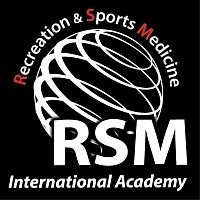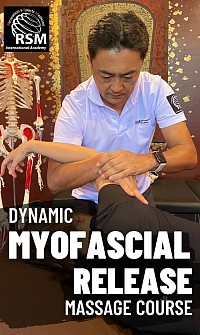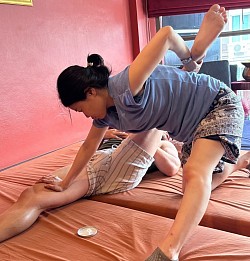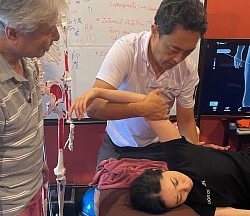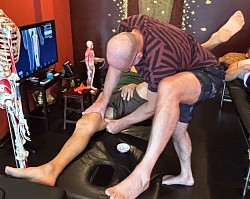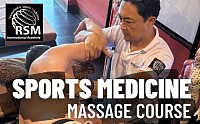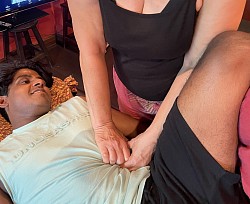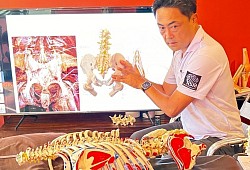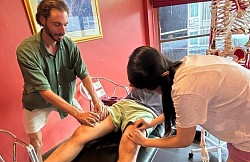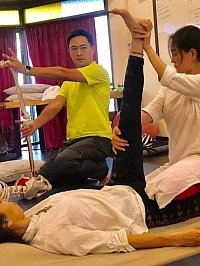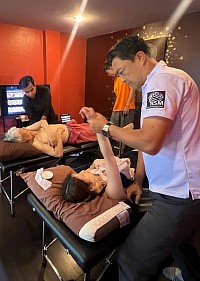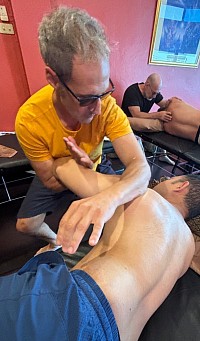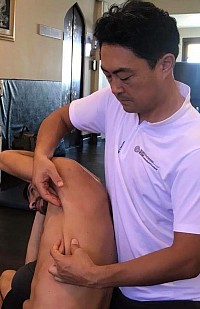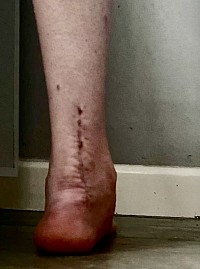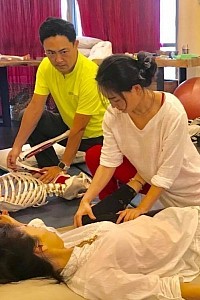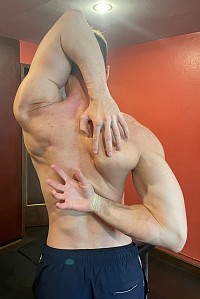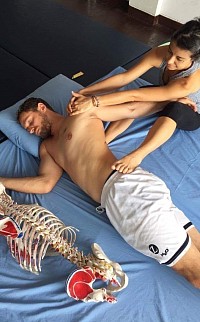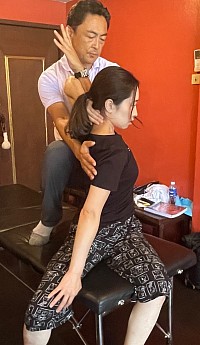Myofascial Release Course
Dynamic Myofascial Release with Stretching
RSM’s Dynamic Myofascial Release (DMR) combines myofascial release with dynamic stretching to enhance Dynamic Postural Stability. By mobilizing fascia and joint capsules, and promoting nerve and muscle glide, DMR improves proprioception and allows muscles to perform at their full potential. This technique alleviates pain, strengthens the kinetic chain, and supports dynamic postural stability, making it ideal for both rehabilitation and sports performance.
🔸 Dr. Amrita from the UK, along with Physiotherapist Philippa, and other professionals, strongly recommend our DMR for all healthcare professionals.
Dynamic Myofascial Release Course Fee & Timetable
🔸 Price: THB 9,000
(approx. EUR 226 / USD 246)
• 5 Days Intensive Course
• The course starts on Monday at 10:00
• Duration: 20 hours
(18 hours + 2 hours of Review)
🔸 Lessons & Massage Training
10:00-12:00 / 13:00-15:00 from Mon to Fri
Lunch break / 12:00 - 13:00 from Mon to Fri
🔸 Following the Dynamic Myofascial Release course, a Sports Medicine Massage Course will be held from 15:30-17:00 .
🔸 This manual therapy training is designed for those who wish to stand out in their profession, as well as medical professionals seeking mastery in pain relief and postural massage.
Targeting Myofascial Adhesions and Enhancing Mobility
Dynamic stretching requires myofascial glide between single-joint and multi-joint muscle functions. Our Dynamic Myofascial Release (DMR) enhances these functions by improving fascial mobility and activating proprioceptors to optimize the kinetic chain. It targets myofascial adhesions, improves nerve glide, and supports dynamic postural stability, enabling pain-free movement. This technique maximizes muscle function, joint mobility, and nerve glide, reinforcing the kinetic chain for rehabilitation and sports performance.
🔸 In this manual therapy training, students gain a comprehensive 120-minute skill set for rehabilitation and performance enhancement.
Enhancing Dynamic Positional Stability:
Integrating Joint Mobilization and Myofascial Release
Dynamic Myofascial Release and joint capsule mobilization enhance joint play, promoting proper joint function for optimized mobility. Muscle tension and myofascial distortion in deep muscle layers limit joint movement, compressing the joint capsule and causing pain-avoidance movements. Techniques like Deep Tissue Massage and Trigger Point Therapy target deep muscle layers, while Active Soft Tissue Release (ASTR) mobilizes inner muscles. This combination dramatically improves muscle and joint function, resulting in smoother, more efficient movement.
🔸 Students will learn to integrate joint capsule mobilization with DMR, improving mobility and muscle function for more efficient movement and better client outcomes.
Advanced Manual Therapy:
Targeting Muscle Tension and Myofascial Adhesions for Optimal Mobility
This advanced manual therapy course focuses on mobilizing nerve pathways through dynamic stretching, myofascial trigger point release, joint mobilization, and Active Soft Tissue Release (ASTR). These techniques activate muscle spindles in response to pain, helping practitioners identify areas of muscle tension, myofascial adhesions, and restricted movement. By targeting these areas, therapists can apply proper techniques to release myofascial adhesions, reduce muscle tension, and restore dynamic postural stability.
🔸 Students can understand muscle spindle activation, clearly identifying target areas of muscle tension, myofascial adhesions, and restricted movement, maximizing the effectiveness of Dynamic Myofascial Release.
Dynamic Myofascial Release for Sports Trainers:
Restoring Kinetic Chain Post-Weight Training Work
RSM’s Dynamic Myofascial Release (DMR) targets specific muscles that become tight from weight training, which can lead to muscle tension and localized discomfort. We will teach you to identify depth-located specific muscle tension that may result in pain, addressing myofascial adhesions and nerve entrapments that cause pain-avoidance movements in the joints. This process restores the natural kinetic chain, improving movement and dynamic stability.
🔸 For sports trainers, DMR is an essential technique for releasing muscle tension and improving mobility. By focusing on tight, specific muscles, it helps restore proper muscle function and optimize performance.
DMR for Accelerated Rehabilitation Protocols
Dynamic Myofascial Release addresses scars in the myofascia, which cause myofascial distortion and muscle glide issues due to adhesions in the scarred area. By releasing these restrictions and improving glide, it's possible to enhance the movement of both muscles and fascia, restoring normal function to nerves and muscles and accelerating rehabilitation. This technique can become a key element in speeding up rehabilitation protocols.
🔸 Students will learn to release myofascial adhesions, improve muscle glide, and accelerate recovery, particularly in post-surgical rehabilitation.
Effective Joint Range of Motion Techniques and Diagnostic Approach
The most effective approach to joint range of motion involves combining dynamic myofascial release with static stretching. By gently moving the joint to 70–80% of its end range and applying dynamic myofascial release, you can assess whether the restriction is due to muscle, joint, or myofascial limitations. This combination becomes a diagnostic tool, allowing you to pinpoint the source of the restriction and optimize treatment.
🔸 This method enhances mobility and provides a precise diagnosis for effective intervention, promoting optimal joint function.
Elevate Your Diagnostic Skills
Enhance your functional diagnostic skills with Dynamic Myofascial Release, focusing on dynamic postural assessment. This manual therapy teaches you to observe joint movements, utilizing functional anatomy to identify pain, muscle glide issues, joint stiffness, and myofascial strain. Through precise palpation, you will diagnose dysfunctions and apply effective treatments.
🔸 Led by Hironori Ikeda, this course equips physiotherapists, acupuncturists, sports trainers, and yoga/Pilates instructors with the ability to assess and address musculoskeletal discomfort, improving proprioceptive feedback and diagnostic precision for better outcomes.
Dynamic Myofascial Release for Yoga and Dance Professionals
RSM’s Dynamic Myofascial Release uses joint capsule mobilization and myofascial techniques within the 60-80% stretch zone to prevent microdamage at the end of the range. This technique improves flexibility by addressing muscle tension and fascia distortion, ensuring safe and effective joint mobility enhancement.
🔸 Ideal for yoga, Pilates, and dance professionals, this method targets extreme joint flexibility demands. It enhances mobility, reduces the risk of injury, and optimizes range of motion, making it essential for professionals working with clients requiring high levels of joint flexibility.
DMR for the Experienced Practitioner
This course is open to massage practitioners with over 3 years of experience or passionate students who have completed our Trigger Point Therapy and Deep Tissue Massage training classes. Participants are expected to have foundational knowledge in functional anatomy and palpation skills for identifying trigger points and muscle tension relief.
The course emphasizes myofascial strain relief, nerve entrapment pain relief, and joint mobilization to improve range of motion and dynamic postural stability. Combining myofascial release with stretching, this practical massage skillset ensures high professional standards.
Our manual therapy training includes hands-on practice and detailed explanations, benefiting participants working in elder care, in post-operative rehabilitation, and with sports athletes.
